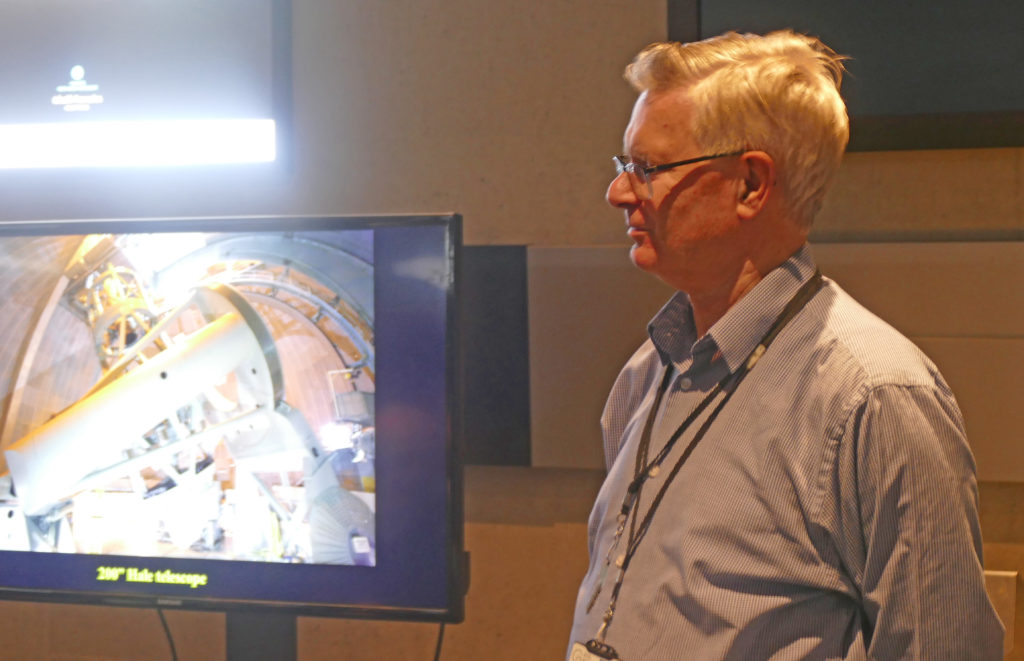April 22, 2019
“Through a Glass Clearly” – History of Astronomy Talk – 19th March 2019
Report by: Bobby Manoo

Who actually invented the refracting telescope? This was the opening question which was put to the audience in our second session for the History of Astronomy group this season. The presenter was Tony Sizer, a former teacher of Chemistry, Science and Astronomy at Warwick School and Chigwell School and is currently one of the astronomers at the Royal Observatory Greenwich.
Tony explained that the concept of the telescope started off with the good old spectacles. The lens for these spectacles was being created by 13th-century monks in Italy. The materials for making spectacles were not particularly good and the process for making the lens was still evolving. However, improvements to the materials and designs eventually triggered the concept behind the telescope using lens. These were known as refracting telescopes.
While it is not known for certain who made the first telescope, most of the credit goes to Hans Lippershey (1570–1619) who was born in Germany and eventually settled in the Netherlands. He was a spectacle maker and used high-quality lenses which were made in Murano, Italy. While there are many stories about how he came across the concept of using a lens for the purpose of magnifying objects, the popular story is that his apprentices were at lunch and discovered that if you placed two lenses together at varying distances from each other, it would magnify an object when viewed through the lens. They did this with a concave lens (eyepiece) in front of a convex lens (objective lens). Hans tried to patent this concept but realized that other spectacle-makers had already made claims of creating a device called a ‘spyglass’. Despite this, Hans went on to design an instrument for magnifying objects and was rewarded by the Dutch government for his designs.
Sometime afterwards, the renowned Italian astronomer, Galileo Galilei (1564–1642), refined the designs of Lippershey’s instrument and started to use it for observational astronomy. This was perhaps the first use of what we now call a telescope for viewing objects in the night sky. Galileo went on to make telescopes based on this concept but they were really at the infancy stage. There was not much magnification and the instruments had a very small field of view. He did, however, manage to get an upright image in a relatively compact design.
The telescope designs from Galileo started to catch the attention of a lot of European astronomers and Johannes Kepler (1571–1630), the German astronomer, decided to make some further improvements for his own observational studies. Kepler used a convex lens for both the objective and eyepiece lens and was able to get a wider field of view. However, this came with some issues. The image was upside down but he found that this could have been corrected by a third lens or a prism. There were also additional issues which he had to try and overcome; among these were dispersion or the scattering of white light, Chromatic aberration which presented varying colours and spherical aberration which created different focus points. The spherical aberration was corrected by using a non-spherical lens (aspherical lens).
British astronomer and mathematician, Sir Isaac Newton (1643–1727) came up with a radical new design when he found that there were too many issues with the refracting telescope and he felt that lenses would always present some degree of chromatic aberration. He decided to instead use mirrors to gather and focus the light from distant objects and hence created the reflecting telescopes or as they are known today, the Newtonian telescope.
Some attempts were made to solve the issue of chromatic aberration with some degree of success. Chester Moore Hall tried to solve this using crown glass to create what he called the achromatic lens. This had some success in that he was able to achieve long-range viewing. John Dollard also tried to improve on the designs many years later by making a crown and flint. This had even more success as it was able to make two wavelengths in one go and help reduce the level of chromatic aberration. Despite all these ongoing issues, Tony concluded that the refractor telescope does give a much better image than reflector telescopes of the same size.
By the end of 1900, lens makers from all over the world were engaged in making bigger lenses. The key issue with making large lens is the holding case around the edge, no matter what, there would be some level of sagging on the lens itself and this, in turn, limited the diameter that they could actually go up to.
Yerkes Observatory, in Wisconsin, USA, has the largest lens ever used for astronomy. It is a 40-inch lens which was installed in the Observatory in the late 1800s. This Observatory is perhaps also well known for its elevating floors which rise and fall to accommodate the viewing eyepiece of the telescope.
The largest lens ever built was on display at the Great Paris Exhibition of 1900. It was 49.5 inches in diameter and was never used for any scientific purposes. It was very cumbersome to move and was only exhibited for about a year. When the exhibition was completed, it was unable to be sold and hence was packed away. It is apparently still stored at the Paris Observatory.
Tony concluded his talk by mentioning that no one has built a large refracting telescope since 1900. Mirror telescopes are now better to build and much more portable.
Thank you, Tony, for an informative and enjoyable evening.
Posted under: Flamsteed, History of Astronomy, Meeting Report




You must be logged in to post a comment.